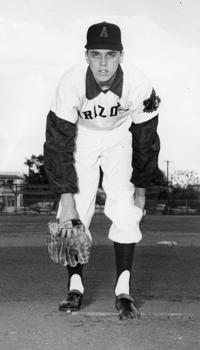Dan Schneider was the best pitcher in college baseball in 1962. He went 13-1. He was a first-team All-American. He struck out 186 batters, which remains an Arizona record 57 years later.
Schneider was also the best bargain in college baseball in 1962, and maybe ever.
“No one ever offered me a scholarship,” he says now, chuckling. “My father was a faculty researcher at the UA, working on his doctorate, so I paid about $125 per semester. I lived at home so I didn’t need a dorm room. The school loaned me my books.”
Schneider struck out 20 batters in one game. His ERA was 1.30, which remains the best career ERA in school history. He didn’t need much help; he pitched 14 complete games in 15 starts.
After starting the ‘62 season 25-1, the Wildcats were ranked No. 1 in the nation, the first time an Arizona team, in any sport, climbed to No. 1.
Schneider, a lefty from Rincon High School, was The Franchise and a very big deal.
The Milwaukee Braves, hoping he would be the “next Warren Spahn,” paid him an almost unheard of $100,000 bonus and Schneider was fast-tracked to the big-leagues, making his debut when he was 20.
But as the years went by, as Arizona won four NCAA baseball championships and became a national power in softball and golf and swimming and men’s basketball, Schneider’s legendary 1962 season faded from memory.
The school created its Sports Hall of Fame in 1976 and it inducted, on average, more than one deserving baseball player per year for more than four decades: Terry Francona, Trevor Hoffman, Eddie Leon, Scott Erickson, 49 and counting.
Finally, last spring, Dan Schneider, now 77, got a long overdue call from UA officials. He had been elected to the Class of 2019.
Schneider will be inducted with six other ex-Wildcats on Thursday night at the Westin LaPaloma Resort.
“Honestly, it hasn’t bothered me; maybe I’ve been a little disappointed, but now that it’s happened it’s very rewarding,” says Schneider, who remains active as an insurance executive in Southern Arizona. “This will be a good occasion to share with my family details about my career. That’s as important as anything.”
Schneider was inducted into the Pima County Sports Hall of Fame in 1996, an honor that was perhaps as much for his leadership and influence in getting the Colorado Rockies to stage spring training at Hi Corbett Field as for his pitching career.
Either way, the pitcher with first-ballot Hall of Fame stuff is finally getting a deserving honor at his alma mater.
Schneider pitched for Hall of Famer Frank Sancet, Class of ‘76, and it didn’t take Sancet long to see that his “walk-on” from Rincon was something special.
After returning from the Canadian summer league in 1961, Schneider had developed a sharp-breaking curveball that set him apart in college baseball, and to MLB scouts.
“The Phillies sent a lot of prospects to Saskatoon; five of my teammates got to the majors,” Schneider remembers. “I was the pitcher of the year and by the time I returned to Tucson for my sophomore season I had progressed so much I felt I had the ability to be Arizona’s No. 1 pitcher.”
Indeed, Schneider started the ‘62 season opener, against UCLA, and struck out 14 Bruins. As Arizona climbed to No. 1 and the Schneider averaged almost 13 strikeouts per game, scouts often filled the seats behind home plate at the old UA baseball facility where the Main Library now sits.
In the days before radar guns, scouts had to guess at the speed of a pitcher’s fastball. One UA professor was so intrigued by Schneider that he developed a system of photographs, frame by frame, as Schneider pitched against a background of black canvas.
“He determined that I was throwing 91 mph,” Schneider says. “It turned a few heads. It sounded impressive.”
At the end of the season, the Braves made Schneider an offer he couldn’t refuse: $100,000. Although he was from an education-first family, Schneider couldn’t pass up the bonus. He left Arizona after one varsity season — in 1961, freshmen were not allowed to play varsity baseball — and began his pro career at Triple-A Louisville, which was almost unprecedented.
His MLB debut was on May 12, 1963, less than a year after Schneider lost his only college game: a heart-breaking 1-0 setback to the Texas Longhorns in the NCAA playoffs in Tucson. Schneider struck out 16 that night; the Longhorns eliminated Arizona and advanced to the College World Series a day later.
“Danny gave up three hits and struck out 16 and we lost,” Sancet told reporters 57 years ago. “We couldn’t have asked for anything better.”
Schneider spent five years in the majors, with the Braves and Astros, and broke into the big leagues with a clubhouse full of future Hall of Famers — Hank Aaron, Warren Spahn, Joe Torre and Eddie Mathews.
“I could tell baseball stories all day,” says Schneider. “One of my favorites was a day we were playing St. Louis, just getting killed, when I was summoned from the bullpen for mop-up duty.
“Eddie Matthews was madder than a wet hen. He was a very commanding presence. He walked to the mound from third base and told me to hit the next batter in the head. It was Tim McCarver. So I threw this dart and it bounced off Tim’s helmet. I thought all hell was going to break loose, but Tim trotted calmly to first and Eddie just stood there, staring into the Cardinals dugout, waiting to fight someone.
“I never became the next Warren Spahn, but I just loved my baseball days.”





